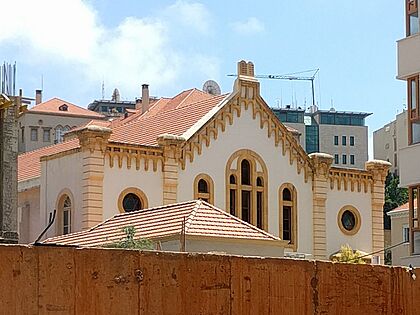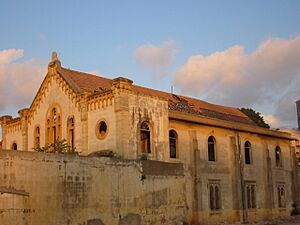Maghen Abraham Synagogue facts for kids
Quick facts for kids Maghen Abraham Synagogue |
|
|---|---|

The synagogue in 2016
|
|
| Religion | |
| Affiliation | Orthodox Judaism |
| Rite | Nusach Sefard |
| Ecclesiastical or organisational status |
|
| Governing body | Lebanese Jewish Community Council |
| Status | Active |
| Location | |
| Location | Wadi Abu Jamil, Beirut |
| Country | Lebanon |
| Architecture | |
| Architect(s) | Bindo Manham |
| Architectural type | Synagogue architecture |
| Architectural style | Rundbogenstil |
| Founder | Moise Abraham Sassoon |
| Completed | 1925 |
The Maghen Abraham Synagogue is a place of worship for people of the Jewish faith. It is located in Wadi Abu Jamil, a historic Jewish neighborhood in downtown Beirut, the capital of Lebanon. A synagogue is a special building where Jewish people gather for prayer and community events.
The synagogue was first built in 1925. It was badly damaged during the Lebanese Civil War, a long conflict in Lebanon. In 2009, work began to repair and restore the building. By 2010, the beautiful synagogue was almost completely fixed. It officially reopened around 2014. In 2020, it was slightly damaged again by large explosions in Beirut's port but has since been repaired.
There is another synagogue in Montreal, Canada, named after this one, called Congregation Maghen Abraham.
Contents
History of the Synagogue
Building a New Place of Worship
A very old synagogue in Beirut was destroyed by a powerful earthquake in 502 CE. Many centuries later, the Jewish community needed a new one. The Maghen Abraham Synagogue was built in 1925. It was named after the father of the man who paid for it, Moise Abraham Sassoon.
The land for the synagogue was a gift from Isaac Mann. The building was designed by an architect named Bindo Manham. The head of the Jewish community, Josef Farhi, helped raise more money to finish the inside. The synagogue became a center for the community. It was used for religious services, classes, weddings, and celebrations.
A Thriving Community
In the 1950s and 1960s, Beirut had sixteen synagogues, and they were all busy. At that time, about 14,000 Jewish people lived in Lebanon. They had the same rights as other groups in the country.
However, a civil war started in Lebanon in 1975. The next year, Josef Farhi worried about the safety of the sacred Torah scrolls (handwritten copies of the most important Jewish texts). He sent them to Geneva, Switzerland. A famous banker named Edmond Safra kept them safe in his bank. Today, many of those scrolls are in synagogues in Israel.
Damage During the War
The Lebanese Civil War (1975-1990) was a difficult time for Beirut. The neighborhood of Wadi Abu Jamil, where the synagogue is, became part of the conflict zone. In 1982, Israeli forces invaded Lebanon. They suspected that enemy fighters had hidden weapons in the area.
On August 12, 1982, an Israeli airstrike hit the synagogue, causing major damage. The building was left in ruins, with rubble everywhere. Marble tablets of the Ten Commandments and a Star of David were shattered. After the attack, the synagogue was abandoned.
The Synagogue's Restoration
Plans to Rebuild
For many years, the synagogue remained a ruin. But the Jewish community, including those who had moved to other countries, hoped to rebuild it. In the late 2000s, plans to restore the synagogue finally moved forward.
The Lebanese government and important community leaders, including the group Hezbollah, supported the project. The Prime Minister at the time, Fouad Siniora, said, "We respect Judaism, just as we respect Christianity. Our only problem is with Israel." A spokesman for Hezbollah also said the group welcomed the restoration of a religious site.
Funding the Project
Restoring the synagogue was expensive. The leader of Lebanon's small Jewish community, Isaac Arazi, said it would cost about $1 million. Money came from different places.
- Private donations from Jewish people around the world raised $200,000.
- A Lebanese construction company called Solidere gave $150,000.
- Banks in Switzerland, owned by people with Lebanese-Jewish roots, also helped fund the project.
A Beautiful Restoration
Work on the synagogue began in 2009. By 2010, the building was beautifully restored. An Israeli newspaper, Haaretz, reported that the "synagogue was restored to glory."
The synagogue reopened around 2014, once again serving as a place of worship. It suffered minor damage during the huge explosions in Beirut's port in 2020 but was quickly repaired. Today, it stands as a symbol of hope and the rich history of Lebanon's Jewish community.
See also
 In Spanish: Sinagoga Maghen Abraham para niños
In Spanish: Sinagoga Maghen Abraham para niños
- Zaki Cohen, Beirut Chief Rabbi
- Jewish Cemetery (Beirut)
- History of the Jews in Lebanon
- List of synagogues in Lebanon



